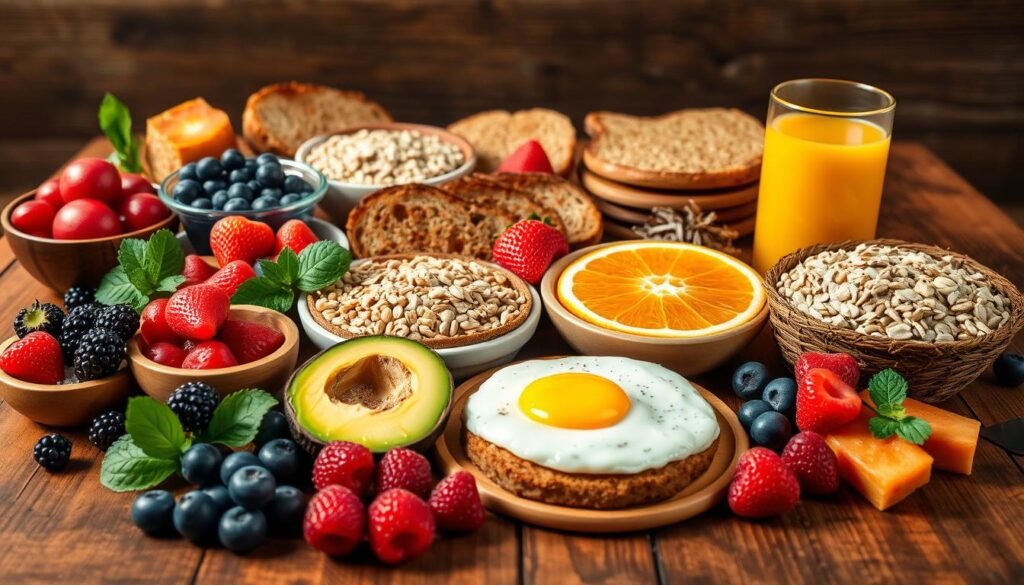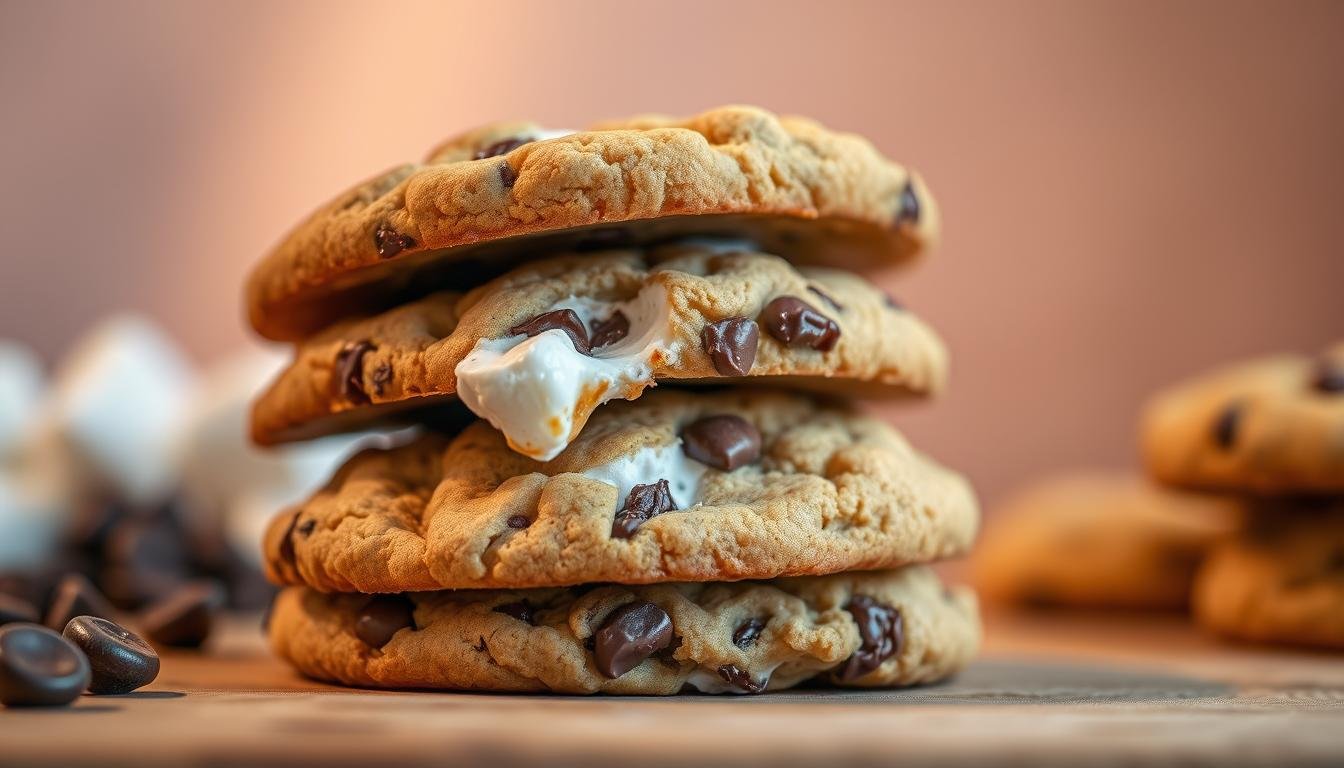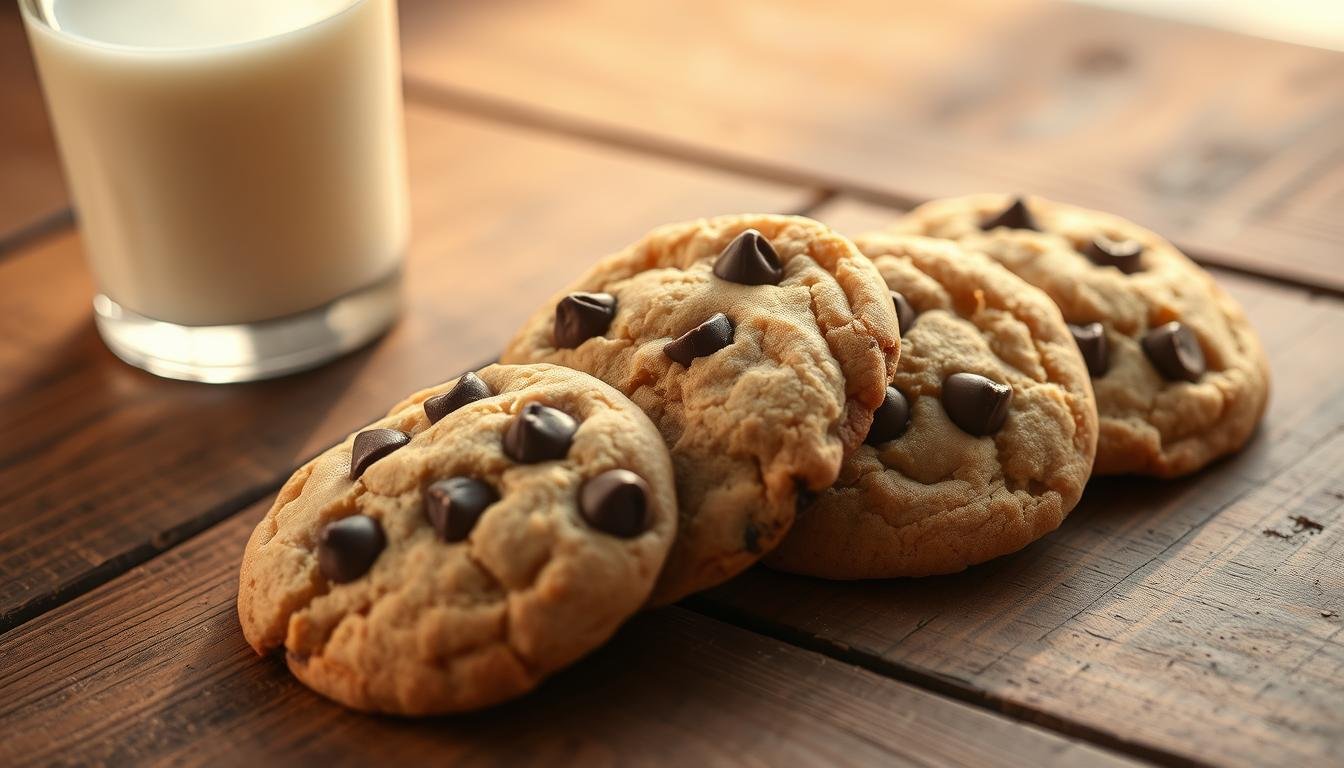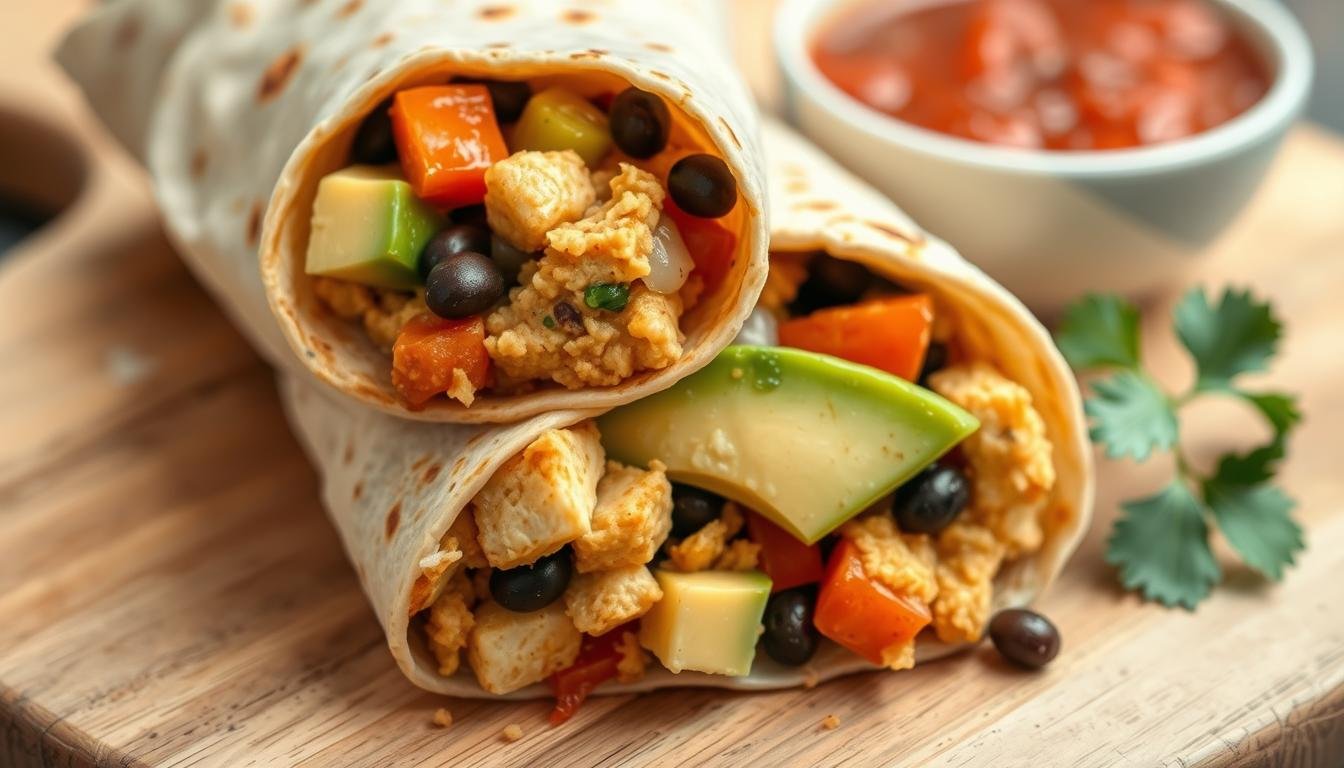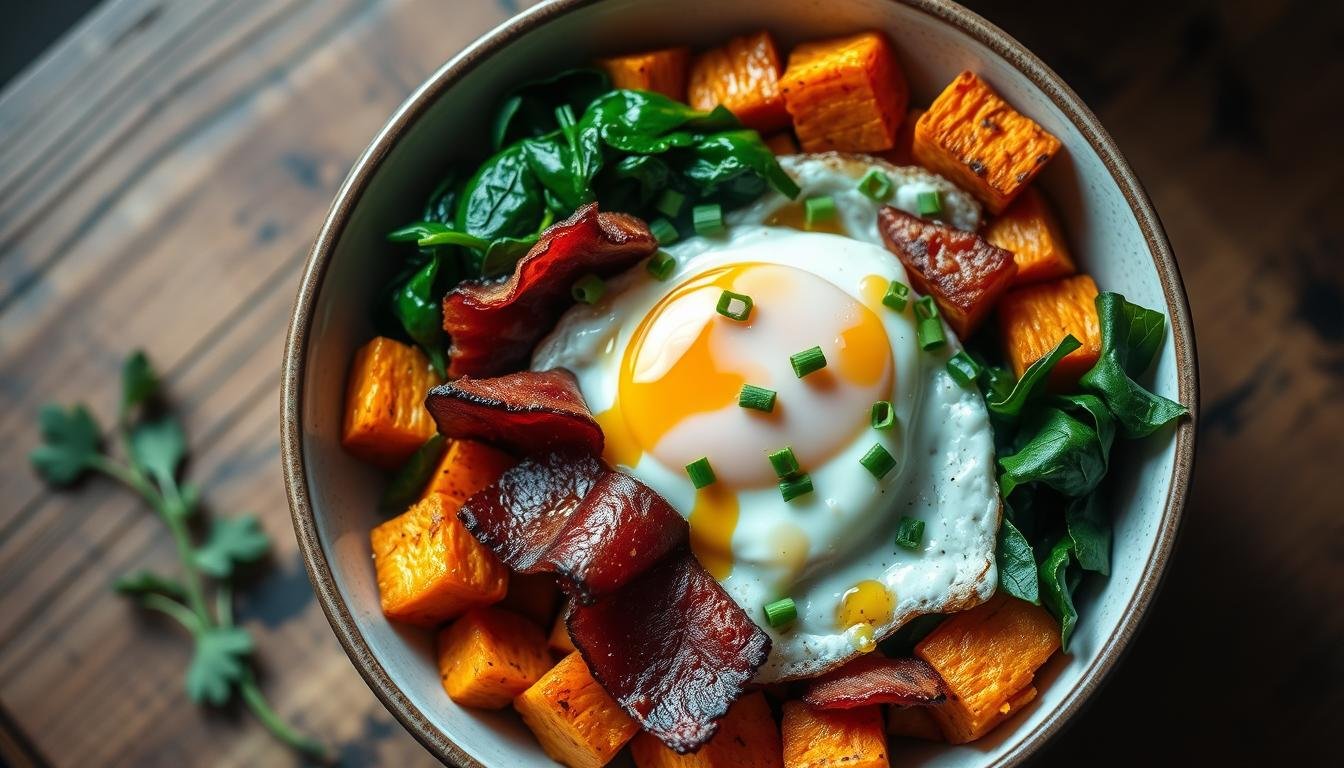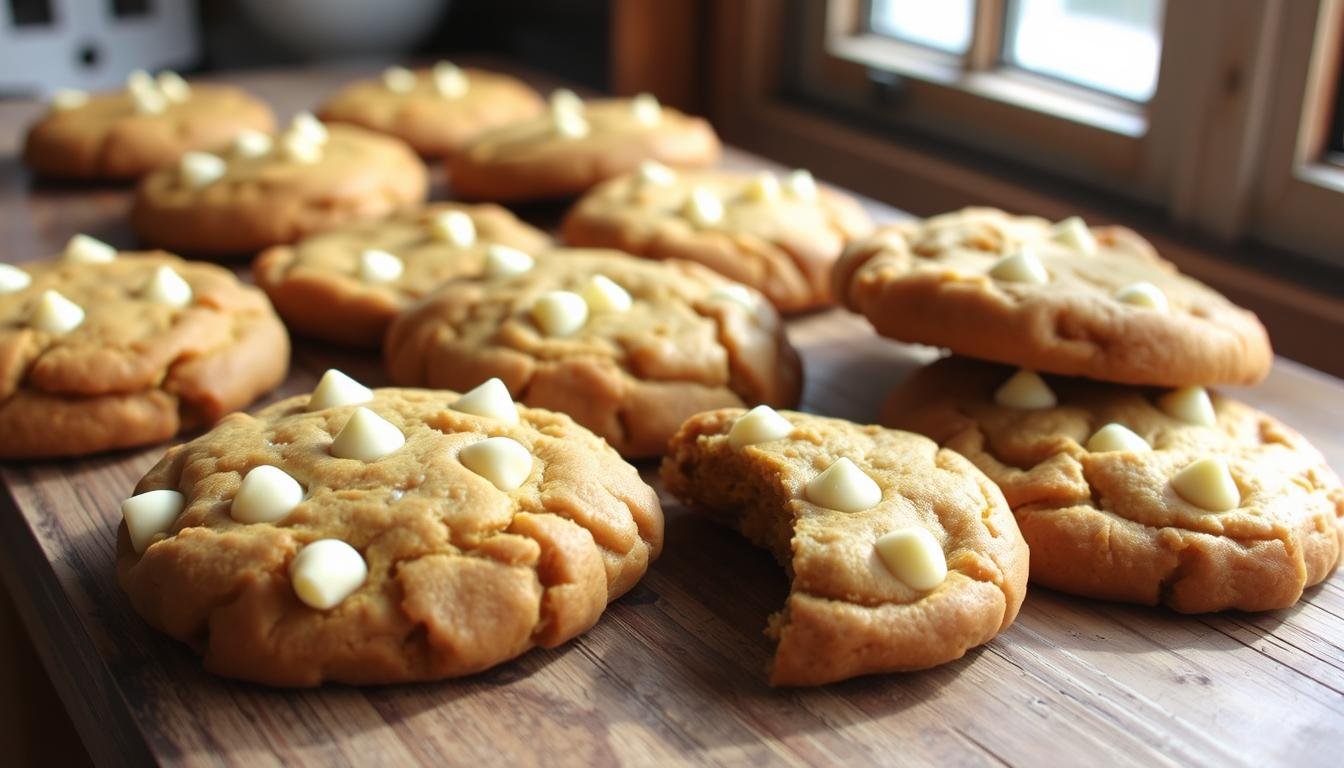I look for easy ways to keep my heart healthy without losing flavor. A good breakfast is key, so I made low-sodium recipes that are quick and healthy. They have less than 600 mg of sodium per serving.
These recipes include tasty vegetarian dishes, high-protein meals, and options good for diabetics. They balance carbs and protein well. Plus, there are quick breakfasts like overnight oats and chia puddings for busy mornings.
Try these recipes for a heart-healthy diet that’s easy to follow. You’ll find dishes that are filling, rich in fiber, and use lean proteins. Seafood and plant proteins are paired with herbs and spices for flavor, not salt.
Key Notes
- Breakfast is an ideal time to start heart-healthy habits with low-sodium morning meal options.
- Most recipes require about 10 minutes active prep and stay below 600 mg sodium per serving.
- Options include vegetarian, high-protein, and diabetic-friendly low-sodium breakfast recipes for heart health.
- Flavor comes from herbs, spices, citrus, and umami-rich ingredients—not added salt.
- Make-ahead and grab-and-go recipes make it easy to eat a nutritious low-sodium breakfast every day.
Why I Prioritize Low-Sodium Breakfast Recipes for Heart Health
I start my day with meals that are good for my heart. I pick recipes with less than 600 mg sodium. This helps me follow the American Heart Association’s daily sodium limit. Plus, these meals are quick to make, perfect for busy weekdays.
Health rationale and sodium targets
I eat breakfasts rich in nutrients like oat bowls and veggie egg dishes. They help me feel full and keep my blood pressure steady. These foods are good for my heart over time because they have fiber, lean protein, and healthy fats.
Risks of excess sodium
I stay away from foods high in sodium. Too much sodium can raise blood pressure and harm my kidneys. But, I’ve found it’s easy to make tasty meals with less salt. For example, grilled lime chicken and cilantro-topped salmon are both delicious and low in sodium.
Flavor without salt
I use fresh herbs, citrus, spices, and different textures to add flavor without salt. A sprinkle of smoked paprika or a squeeze of lemon can make a dish special. These tricks make low-sodium breakfasts enjoyable for everyone, helping me keep up with healthy habits.
What Makes a Heart-Healthy, Low-Sodium Breakfast: Nutrients to Balance
I look for breakfasts that give me steady energy and are low in sodium. A good morning meal should have protein, fiber, and healthy fats. This keeps me full and helps control blood pressure. I eat foods like eggs, Greek yogurt, oats, chia, avocado, nuts, and fruit to meet these needs.
Protein is key in my breakfast. I eat eggs, cottage cheese, Greek yogurt, and peanut butter. These foods help build muscle and keep me full. They also help control cravings later in the morning.
Fiber is important for digestion and blood sugar control. I add oats, chia, berries, bananas, and leafy greens to my meals. These foods help keep my heart healthy and calories in check. Swapping steel-cut oats for instant oats adds more fiber without extra salt.
Healthy fats add flavor and help with nutrient absorption. Avocado, walnuts, and olive oil are great choices. They replace processed spreads that often have hidden salt.
It’s important to know how much to eat. I aim for a protein portion the size of one palm, a cup of whole grain or fruit, and a small amount of healthy fat. This helps me make dishes like kale & avocado omelets or overnight oats with peanut butter.
For those managing blood sugar, I choose quality carbs with protein and fat. Diabetic-friendly options include oat bowls, baked porridge with bananas and walnuts, and veggie egg bakes. These meals are heart-healthy and keep blood sugar in check.
When planning meals, I check labels and make simple swaps. I avoid canned foods and processed meats because they have a lot of sodium. Instead, I use fresh poultry, seafood, and plain dairy. This way, I can make tasty, low-sodium breakfasts that are good for my heart.
It’s important to make meals satisfying and easy to prepare. I make overnight oats, prep veggie egg cups, and portion nuts. This way, I have healthy options ready to go, even on busy mornings.
My Top 10 Low-Sodium Breakfast Recipes Overview
I picked ten easy low-sodium breakfast recipes. They balance taste, speed, and heart-friendly nutrition. Each recipe takes about ten minutes of active prep and stays under 600 mg sodium per serving. I focus on meals that fit busy mornings while keeping flavor high without added salt.
I tested crowd favorites with strong user ratings. These include baked banana porridge, vegetable egg dishes, and fruit-forward smoothies. These low-sodium morning meal options prove that recipes people enjoy can meet cardiac sodium goals. I include make-ahead choices and quick mixes to suit weekday routines.
Fast prep and sodium goals
My aim was clear: fast prep and predictable sodium. Most dishes finish in ten minutes of active work. I measured ingredients to keep sodium under 600 mg per serving so readers can manage daily totals with confidence.
I include protein-focused entries inspired by lean proteins like grilled salmon and lime chicken adapted for breakfast. Think smoked salmon alternatives and egg-plus-fish pairings that deliver savory depth without added salt. These options support heart health while boosting satiety.
Variety for different diets
The top ten list covers vegetarian, plant-based, high-protein, diabetic-friendly, and make-ahead categories. This range helps anyone find low-sodium breakfast ideas for a healthy heart that match personal preferences and dietary needs.
Below I summarize the ten recipes and why each made the cut. The selection blends textures, flavors, and cooking methods so you can rotate meals. You will find smoothies, overnight oats, parfaits, egg dishes, and a few seafood-inspired options that work well as low-sodium morning meal options.
| Recipe | Category | Active Prep | Estimated Sodium per Serving | Why I Recommend It |
|---|---|---|---|---|
| Peanut Butter Protein Overnight Oats | Make-ahead, High-protein | 5–10 min | ~300 mg | Fast, filling, balances protein and fiber for mornings on the go. |
| Avocado & Kale Omelet | Vegetarian, High-protein | 8–10 min | ~250 mg | Creamy texture with herbs adds flavor without salt. |
| Quinoa-Chia Parfait with Kefir | Plant-based, Make-ahead | 10 min | ~200 mg | Protein-rich and probiotic, great for gut and heart health. |
| Cherry Vanilla Smoothie with Red Lentils | Smoothie, Diabetic-friendly | 5 min | ~150 mg | Lentils add protein and lower glycemic load for steady energy. |
| Chocolate Chia Pudding with Raspberries | Plant-based, Make-ahead | 5–8 min | ~120 mg | Indulgent texture, low sodium, appeals to sweet cravings. |
| Baked Banana Porridge | Comfort, Vegetarian | 10 min prep | ~180 mg | Warm, portable, naturally sweet with whole grains. |
| Vegetable Egg Skillet | High-protein, Low-sodium morning meal option | 10 min | ~220 mg | Veggies add bulk and flavor; herbs replace salt for zest. |
| Tofu Scramble with Spinach | Plant-based, High-protein | 8–10 min | ~190 mg | Firm tofu and turmeric create savory depth without sodium. |
| Smoked Salmon Alternative Bowl | High-protein, Seafood-inspired | 10 min | ~350 mg | Uses low-sodium fish or canned alternatives to mimic classic flavors. |
| Muesli Mason Jar Yogurt Parfait | Make-ahead, Diabetic-friendly | 5–8 min | ~160 mg | Customizable fiber and protein make it a balanced grab-and-go choice. |
These selections show how simple swaps and smart portions create a reliable set of easy low-sodium breakfast recipes. You can mix and match for weeklong variety while keeping sodium in check. Use herbs, citrus, and umami-rich low-sodium ingredients to keep flavor high.
Easy Low-Sodium Breakfast Recipes I Make for Busy Mornings
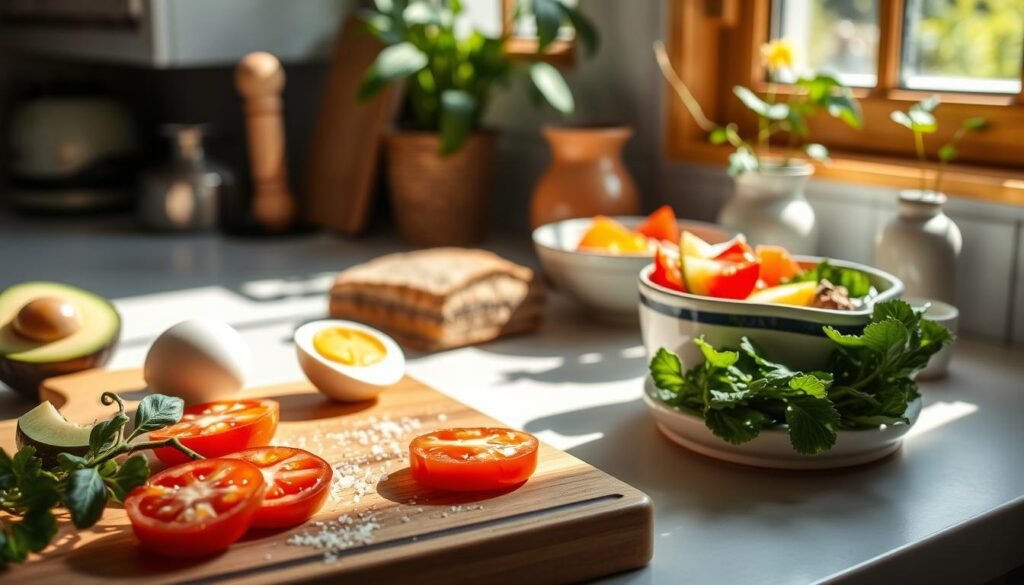
I have a few quick breakfasts that are good for my heart and fit my busy schedule. These recipes are easy to make, can be taken on the go, and don’t have too much sodium. Here are three of my favorites, along with tips for making them ahead of time.
Peanut Butter Protein Overnight Oats
I mix oats, peanut butter, chia, and plant milk the night before. Adding protein powder or Greek yogurt makes it filling. Banana slices and cinnamon add flavor without salt.
This recipe is great for meal prep and has less than 600 mg sodium per serving.
Avocado & Kale Omelet
I cook kale in olive oil until it’s soft. Then, I mix it with eggs and mashed avocado. This mix is full of protein, fiber, and healthy fats without salt.
I add black pepper, lemon zest, or cherry tomatoes for extra flavor.
Cherry Vanilla Smoothie with Red Lentils
I cook red lentils, cool them, and blend with cherries, vanilla, and milk. The lentils add protein and make it creamy. A little maple syrup sweetens it when needed.
This smoothie is tasty and easy to take on the go.
These recipes show how to make tasty, low-sodium breakfasts without much seasoning. I use texture, acid, and spices to keep things flavorful while keeping sodium low.
Vegetarian and Plant-Based Low-Sodium Breakfast Ideas
I use simple plants for my morning meals. They are low in sodium and full of fiber, healthy fats, and sweetness. This makes my breakfasts feel good without salt.
Quinoa-Chia Parfait with Kefir or Plant Milk
I cook quinoa and let it cool. Then, I layer it with chia seeds and kefir or oat milk. Quinoa adds protein, chia seeds give omega-3s and fiber, and kefir has probiotics.
I add a bit of maple syrup for sweetness. I top it with apple or kiwi for crunch. This is a great low-salt breakfast that’s easy to make ahead.
Overnight Oats: Pumpkin Ricotta or Tropical Coconut
Overnight oats are great for busy mornings. For pumpkin ricotta, I mix oats with ricotta, pumpkin, cinnamon, and almond milk. For tropical coconut, I use oats, coconut milk, mango, and coconut flakes.
Both are low in sodium but feel like treats. They’re perfect for a heart-healthy breakfast.
Chocolate Chia Pudding with Raspberries
I mix chia seeds with cocoa, milk, and vanilla, then chill it. Fresh raspberries add flavor and vitamin C. This pudding is rich in omega-3s, fiber, and calcium without much sodium.
I love this for a quick, tasty breakfast. It’s easy to make and supports my heart health.
I change up these bowls to keep things interesting. They’re easy to prepare and help me meet my blood pressure goals. Plus, they taste great!
High-Protein, Low-Sodium Breakfast Recipes for Cardiovascular Health
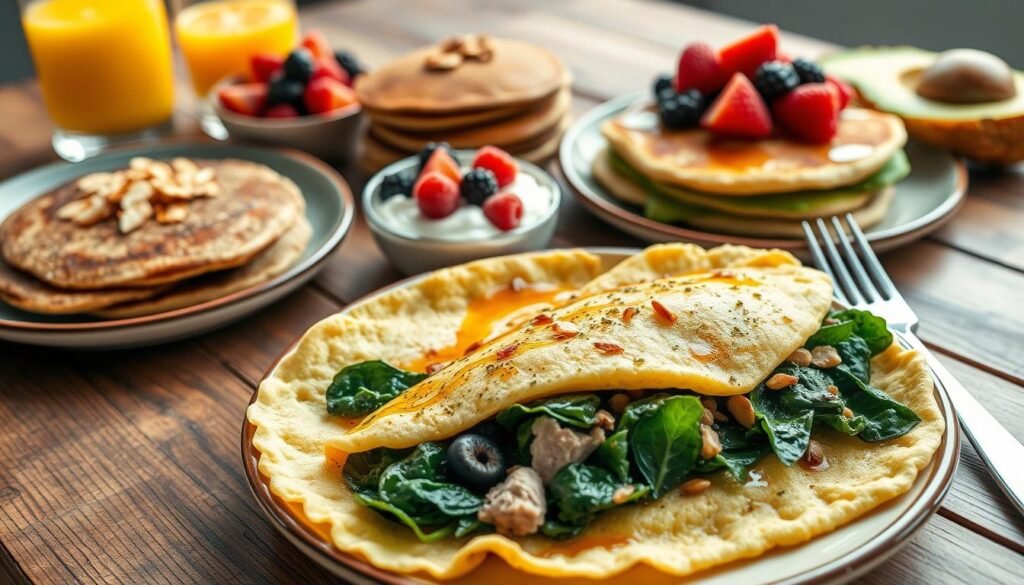
I start my day with protein-rich meals that are low in salt. A good breakfast keeps my blood pressure steady and my energy up. Here are three easy recipes that are both protein-packed and low in sodium.
Kale & Avocado Omelet
I use whole eggs or egg whites for extra protein in my omelet. I cook chopped kale in olive oil and add mashed avocado at the end. The kale gives me fiber, and the avocado is good for my heart.
I don’t add salt. Instead, I use lemon juice and black pepper for flavor.
Greek Yogurt Bowls with Blueberries and Honey
Plain Greek yogurt is my go-to for a low-sodium, high-protein breakfast. I add fresh blueberries, honey, and toasted walnuts on top. This mix is full of protein, fiber, and healthy fats.
It’s one of my top choices for a heart-healthy breakfast that’s low in sodium.
Tofu Scramble or Savory Breakfast Sandwich with Veggies
For a plant-based option, I use unsalted tofu with turmeric, bell pepper, and spinach. When making a breakfast sandwich, I choose low-sodium bread. I add tomato, arugula, and avocado for extra flavor.
These recipes help me feel full and support my heart health. They’re low in sodium and don’t lack in taste.
Make-Ahead and Grab-and-Go Low-Sodium Breakfast to Go Options
I keep mornings calm by using simple recipes. On Sundays, I make a week’s worth of low-sodium breakfasts. These meals are quick, healthy, and don’t have too much salt.
First, I make overnight oats and chia puddings. They’re easy to make and can be made in bulk. I use almond milk, oats or chia seeds, cinnamon, and fruit. This way, I have four healthy breakfasts ready for the week.
For no-cook meals, I make muesli and mason-jar yogurt parfaits. I pick unsweetened muesli and Greek yogurt to keep sodium low. I add berries, walnuts, and maple syrup for flavor without salt.
For busy days, I prep protein-rich pots and sandwiches. I make egg cups, grilled chicken, tofu, or veggie sandwiches. These are easy to take with me and keep me full.
Here’s a quick guide to help plan your breakfasts. It shows prep time, how long they last, protein, and how well they travel. Use it to mix and match breakfasts that fit your busy schedule.
| Option | Prep Time | Shelf Life (Refrigerated) | Protein (approx.) | Best For |
|---|---|---|---|---|
| Overnight Oats (rolled oats + milk) | 5–10 minutes per batch | 4–5 days | 8–12 g per serving (add Greek yogurt for more) | Quiet mornings, commuting |
| Chia Pudding (chia + milk) | 5 minutes | 5–6 days | 4–6 g per serving (boostable with protein powder) | Make-ahead low-sodium breakfast jars |
| Muesli + Mason-Jar Yogurt Parfait | 10 minutes | 3–4 days | 12–18 g per serving (with Greek yogurt) | Crunchy texture, no baking |
| Egg Cups or Tofu Scramble Pots | 30–40 minutes (bake once) | 4–5 days | 10–15 g per serving | High-protein mornings, portable |
| Veggie Breakfast Sandwich (low-carb bread) | 20–30 minutes | 3–4 days (assemble before eating) | 12–20 g per sandwich | Handheld option for busy days |
Low-Sodium Breakfast Foods List for Inspiration
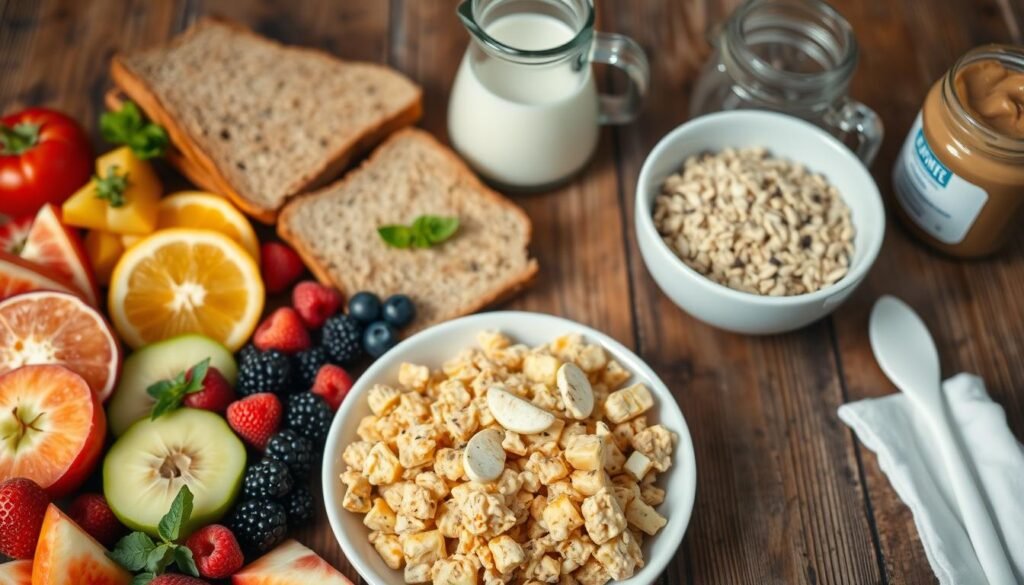
I keep a simple pantry and fridge list for easy mornings. My choices are full of flavor, texture, and nutrients. They also avoid too much sodium. Here are the pantry essentials, fresh produce, and proteins I always go back to.
I stock up on low-sodium pantry items for many recipes. I have powdered peanut butter, chia seeds, oats, quinoa, and unsalted red lentils. I also keep natural nut butters, maple syrup, and vanilla extract on hand. For extra flavor, I add cacao nibs, cinnamon, cardamom, citrus zest, and toasted nuts.
My list of heart-healthy breakfast ingredients includes berries, bananas, walnuts, spinach, kale, and mushrooms. I also use low-fat yogurt. These add fiber, vitamins, and texture to my breakfasts. Frozen berries and fresh bananas are great for quick, sweet treats.
For protein, I choose salmon, mahi mahi, chicken breast, tofu, and lean deli meats. Grilled salmon or chicken make great breakfast wraps. Tofu scrambles with turmeric and spinach are also a tasty, low-sodium option.
Here’s a quick shopping list I use for breakfast. It includes pantry items, flavor boosters, produce, and proteins. It’s perfect for any diet and saves time in the morning.
- Low-sodium pantry staples: powdered peanut butter, chia seeds, oats, quinoa, unsalted canned legumes, natural nut butters, maple syrup, vanilla extract
- Flavor enhancers: lemon or orange zest, vanilla, cinnamon, cardamom, cacao nibs, mixed nuts and seeds
- Fresh produce: bananas, mixed berries, spinach, kale, mushrooms
- Protein picks: salmon, mahi mahi, chicken breast, tofu, low-sodium lean meats
- Convenience items: low-fat yogurt, kefir, frozen fruit, pre-cooked quinoa
I change up these items each week. This keeps my meals interesting, reduces sodium, and makes healthy breakfasts easy and delicious.
Diabetic-Friendly Low-Sodium Breakfast Recipes and Modifications
I focus on breakfasts that keep blood sugar steady and sodium low. I pair carbs with protein and healthy fats to reduce glucose spikes. Small portions of maple syrup or honey can add sweetness without excess sugar. My aim is to make diabetic low-sodium breakfast recipes that taste good and support heart health.
I manage carbs and sodium together by measuring servings and choosing whole foods. For example, I make overnight oats with added protein powder or Greek yogurt. I balance fruit with nuts or seeds to slow digestion. These steps help keep meals within recommended sodium targets and support long-term cardiovascular goals.
Below are simple modifications I use to make each recipe diabetic-friendly. I swap flavored yogurts for plain Greek yogurt, use unsweetened plant milk, and choose canned items labeled low-sodium or no-salt-added. When I cook eggs or salmon, I skip added salt and use herbs and lemon for brightness.
Managing carbs and sodium together
I track carbohydrate portions and combine them with protein at every meal. A quinoa-chia parfait with kefir gives fiber and protein, while an oatmeal bowl with peanut butter adds healthy fat. I limit added sugars and watch serving sizes to maintain steady energy and avoid high sodium.
Sample diabetic low-sodium breakfast choices
- I often prepare a Greek yogurt bowl with berries and a sprinkle of walnuts. Protein and fiber slow glucose and keep sodium low.
- Baked banana oat porridge with chopped walnuts replaces refined sugar and provides steady energy. I use rolled oats, egg whites, and mashed banana for texture and protein.
- Veggie-packed egg cups with spinach, bell pepper, and a touch of feta made from reduced-sodium cheese serve as a grab-and-go option.
- Quinoa-chia parfait layered with kefir, fresh berries, and cinnamon gives a balanced mix of carbs, protein, and healthy fats for cardiovascular benefit.
- Salmon and avocado on whole grain toast uses canned or cooked salmon labeled low-sodium. I add lemon and dill for flavor instead of salt.
I keep most servings under 600 mg of sodium by choosing fresh produce, plain dairy, and no-salt-added pantry items. Taste-of-Home style portion guidance helps me count lean-protein exchanges when I include eggs, chicken, or salmon.
For easy planning, I batch-make veggie egg cups and overnight oat jars. I portion them before storage so carb counts and sodium stay consistent. These low-sodium breakfast ideas for a healthy heart and low-sodium breakfast recipes for cardiovascular health fit into a weekly routine with little fuss.
Taste Tips: How I Keep Flavor High Without Adding Salt
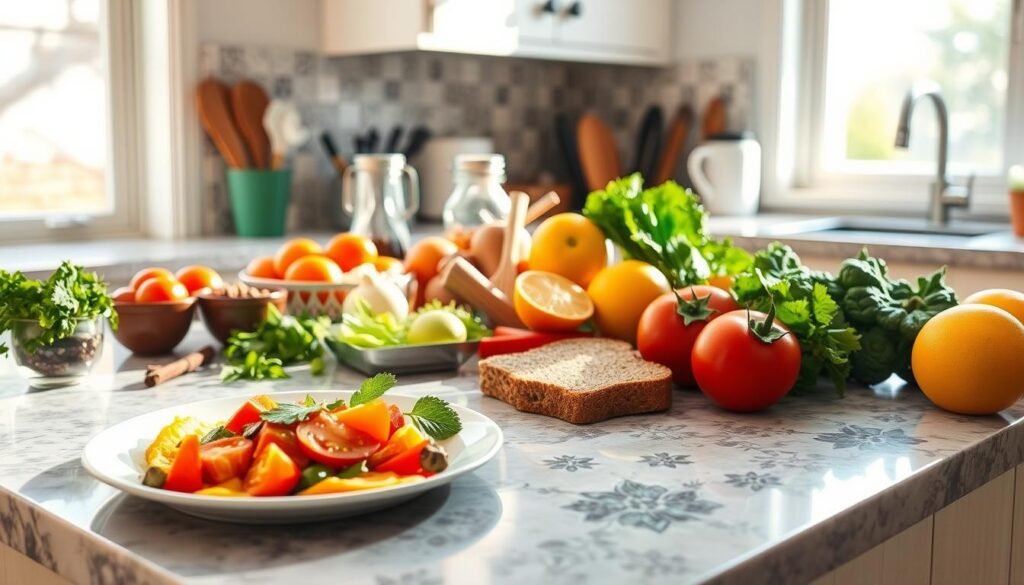
I start every low-salt breakfast with a flavor plan. I choose a bright acid, an aromatic herb, and one umami element. This trio makes simple foods like oats or eggs taste great.
Herbs, spices and acids
I use citrus zest, lemon juice, or apple cider vinegar to add brightness. Fresh herbs like dill, cilantro, and chives add flavor. Ground spices like cinnamon and smoked paprika add depth without salt.
Umami tactics
For umami, I use mushrooms and sun-dried tomatoes in small amounts. Toasted nuts and cacao nibs also work. A little miso in yogurt or kefir adds complexity.
Texture and temperature
I mix textures and temperatures in my dishes. Creamy ricotta with crunchy almonds is a favorite. Warm porridge with cold berries is refreshing.
Techniques for savory dishes
I slow-cook eggs with kefir for a silky texture. Briefly marinating fruit or proteins in citrus and herbs boosts flavor. Taste of Home recipes show how marinades and herb rubs can make dishes bold without salt.
Practical mix-and-match ideas
- Greek yogurt + lemon zest + toasted walnuts + a pinch of cinnamon for a balanced bowl.
- Sauteed mushrooms + chives + a squeeze of lime over scrambled eggs.
- Warm quinoa porridge + vanilla + chopped roasted pecans + fresh berries.
I use these tips every week. They help me make delicious, low-sodium breakfasts that are full of flavor and texture.
Practical Tips for Preparation, Portioning, and Nutritional Balance
I keep my morning routines simple. This makes it easier to have low-sodium breakfasts. I make recipes that take about 10 minutes to prepare. I also batch-make foods like overnight oats and quinoa parfaits for several days.
Planning ahead is key. I double or triple recipes and store them in glass jars. This saves time and keeps sodium levels low all week.
Quick prep strategies and time-saving tools
I use a few tools to save time. A slow cooker for baked oats and a rice cooker for quinoa are my go-tos. I also use a blender for smoothies. Mason jars help me make overnight oats quickly and easily.
Reading labels and sodium awareness
Checking labels is a habit I have. I look at the Nutrition Facts panel for sodium content. I compare brands to find the lowest sodium options.
I follow diabetic exchange notes for portioning. I pair carbs with protein and healthy fats to keep blood sugar steady. For example, a jar of overnight oats with oats, milk, and peanut butter butter is a balanced meal.
Adapting recipes for families and picky eaters
I choose simple, family-friendly dishes like baked porridge and vegetable egg muffins. For kids, I use fruit toppings and mild nut butters. This way, they can add their favorite toppings without adding salt.
I teach others to taste food first. Then, they can add citrus, herbs, or Parmesan for flavor. This keeps sodium low while adding taste for everyone.
Conclusion
I found that making small changes in the morning can really help your heart health. Recipes like Peanut Butter Protein Overnight Oats and Avocado & Kale Omelet are quick and under 600 mg of sodium. They keep you full and support a healthy heart.
My research shows that oat bowls, veggie egg dishes, and yogurt with fruit are great choices. Adding lean proteins and seafood is easy with fresh herbs and citrus. This way, you can enjoy tasty meals without too much salt.
Start by choosing a few favorite recipes and prep them on the weekend. Always check the labels of packaged foods. With these tips, you can enjoy delicious, heart-healthy meals every day.

